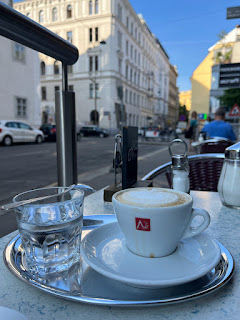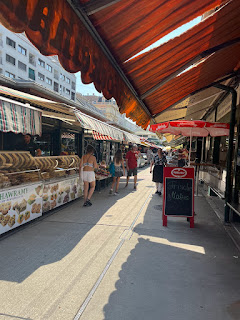Hola todos,
I am so excited to be in a new city! There is so much more to see and explore, and Vienna certainly holds a lot of potential for tourists, based on the too-long list of things I'd like to do.
I was ready to get going this morning a bit earlier than my parents were, so I went out to a cafe for coffee and to scope out a bit of the neighborhood. I got a cafe melange, a typical Viennese coffee, which seems like a cappuccino made with coffee (as opposed to espresso) and topped in a sweeter whipped cream (as opposed to steamed milk and foam). So it's a little lighter in flavor and a bit sweeter than a cappuccino. Perfect for a morning sip!
The third district, while being super close to downtown/historic Vienna, is super residential. While the subway lines are close by and the area doesn't feel too suburban, there were families walking their kids to school as I people-watched at the cafe.
I headed back to the Airbnb, we breakfasted, and then we headed off to downtown Vienna! It was time for our guided tour. Our tour was amazing and we covered so much ground (both physically and figuratively!) that I won't be able to relate it all perfectly here. I guess you'll just have to go to Vienna for yourself!
Vienna is about 2,000 years old (um, I'm sorry... what?!) because it was initially a Roman military settlement along the Danube. Today, Vienna holds roughly 2 million of Austria's 10 million citizens. And while 25% of the city was bombed during World War II (mostly toward the end of the war), the damage was concentrated at train stations, so many of the buildings throughout the city are their original architecture and structure.
Following World War II, Austria was divided in four by the Allies. When Austria regained its autonomy, it promised neutrality in the Cold War. To this day, they’re still not a part of NATO. (However, they are a member of the EU.) This neutrality is also part of the reason that Vienna is the spying capital of the world. They estimate around 7,000 spies are in Vienna currently (but how they get that estimate, I have no idea…)
Regardless, there are a lot of international citizens here. The 1990s brought significant regrowth to Vienna after the collapse of the Soviet Union, and now 35% of Vienna's residents aren’t Austrian.
For several years now, Vienna has been ranked as the most livable city in the world. Given its subway system, walk-ability, and cost of living, I believe it.
Cafes are a big aspect of social life in Vienna. In 1683, coffee was introduced when the Ottomans attempting to invade Vienna left coffee beans in their camp following their retreat. Sit-and-sip culture is big here. (My kind of place!)
Our first stop on the tour, right in the heart of downtown, was the state opera house. They do performances of new shows daily at the opera house and they completely tear down and reassemble each set as needed. On weekends, they'll do multiple different shows (not just performances! shows!!) per day.
We spent quite a bit of time in and around the Hofburg Palace. Started around the 1300s and gradually added to by each successive ruling generation of Hapsburgs, the Palace is a huge complex that today holds several gardens and museums. Portions of it are also used by the current government, including by the President. In total, the complex has 2,600 rooms. (We also found out that you can rent a "flat" or apartment in the Palace too! There is a waiting list, but the units are rent controlled, so that aren't that unaffordable, at least according to our tour guide.)
The Palace courtyard is one place where you can see the walls of additions that were made centuries apart. So on one wall are the remnants of a medieval gate and a moat; the next wall over was built in the 19th century.
This is the old medieval gate in the Palace wall.
The Hofburg also holds the Austrian national library, which is both a museum and a functional research library. They have a collection of every printed work discussing Austria in their archives.
Vienna is also the city of Mozart and Beethoven. Apparently, Mozart had 14 residences throughout Vienna during his lifetime, and Beethoven had 70.
Left: A sculpture of Mozart in the Hofburg Palace gardens. Right: Mozart lived in one of these apartments!
We concluded our tour at St. Stephan’s Cathedral, but I’ll talk more about that tomorrow.
For now, it was time to meet up with my dad’s cousin Brett who has lived in Vienna for 25 years. Brett was incredibly generous with his time and was our supplemental/locals-only tour guide for, like, 8 hours. He showed us all sorts of nooks and crannies and hidden gems in the city. (And we got to catch up with him, since we hadn’t seen him in over a decade!)
Our first stop was lunch post-tour at Cafe Diglas, which was cute and near the tourist city center.
Then we checked out this Burger King, which now occupies the top half of a former concert hall. (A shoe store occupies the lower half now—no pictures allowed, though.)
We passed through Karlskirche, a Catholic church with a great plaza, Naschmarket (pronounced “nosh—market”—I didn’t know we got the word for snacking from German!), the MuseumsQuartier (the largest space dedicated to art on the European continent, I think?), and so much more.
We grabbed a few cold drinks at 7 Stern Brau’s internal patio.
Then we passed an excavated site which shows the different layers of civilization on which Vienna is built. They can’t excavate the whole city, so they exhibit this area as a sample of what is all around Vienna.
We saw the Spittelau incinerator and then walked along the Donaukanal, a small river canal off of the Danube. There were beautiful bike and walking paths and green space along the canal.
The Vienna incinerator! Random, I know. But a cool piece of functional art nevertheless.
We ended the night at Weinschenke in the second district for dinner and then walked through the lively (read: bar, party, and hostel) Bermuda Triangle district to the subway home.
It was a super full day (30k+ steps 😅) but we were so grateful for the double tours! And we have plenty left to check out.
Besos,
Tina the ExploraDora




















No comments:
Post a Comment